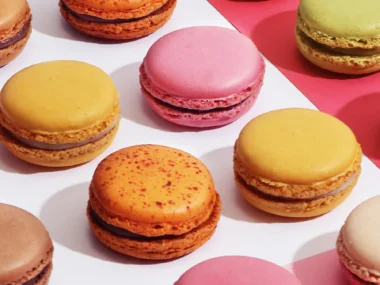Table of Contents Show

When we talk about Alsatian culinary traditions, one pastry comes to mind: the Kouglof. This brioche, typically shaped like a crown with a soft, airy crumb, holds a special place in the hearts of Alsatians. But where does this unique pastry come from, and what makes it so special?
A Brief History of the Kouglof
The Kouglof, also known as “Gugelhupf” in German, is a traditional cake with origins dating back to the 17th century. It is closely tied to the history of Alsace, a region at the crossroads of French and German cultures. According to legend, it was the Three Wise Men who brought the recipe during their journey to Bethlehem, offering a cake shaped like a turban. Another story suggests that Marie-Antoinette, originally from Austria, popularized this cake at the French court.
Traditionally served during special occasions and village festivals, the Kouglof has become an emblem of Alsatian gastronomy. Its distinctive shape, achieved through a specific mold, symbolizes harmony and abundance. The raisins, soaked in kirsch or rum, add a touch of sweetness and conviviality to this cake, already rich in symbolism.
1. The Earthenware Mold from Soufflenheim: Authenticity at the Service of Flavor
By choosing an earthenware Kouglof mold from Soufflenheim, you are doing more than simply acquiring a kitchen utensil. You are supporting local craftsmanship and preserving a precious cultural heritage. Every Kouglof prepared becomes a celebration of Alsatian heritage, adding an emotional dimension to your gourmet moments.
Advantages:
- Even and Gentle Cooking: Earthenware offers a slow and uniform heat distribution, ensuring a perfectly baked Kouglof, soft inside and delicately golden on the outside.
- Respect for Tradition: Handmade in Soufflenheim, an Alsatian village renowned for its pottery, these molds embody ancestral know-how passed down through generations.
- Unique Aesthetic: Each mold is a one-of-a-kind piece, often adorned with traditional motifs, bringing a touch of elegance to your kitchen.
- Durability: With proper care, an earthenware mold can last for decades.
Disadvantages:
- Fragility: Earthenware is sensitive to shocks, requiring careful handling.
- Specific Maintenance: Hand washing is recommended to preserve the mold’s quality. Avoid using a dishwasher.
- Preheating Time: It is best to gradually preheat the mold to avoid thermal shock.
- Price: An earthenware Kouglof mold tends to be more expensive, but this is a guarantee of quality.
2. The Metal Mold: Modern Efficiency
The metal Kouglof mold is the preferred choice for those seeking efficiency and practicality. Often available at affordable prices, it is perfect for busy or beginner cooks who want to successfully bake their Kouglof with minimal effort. Its lightness and ease of use make it an everyday ally.
Advantages:
- Quick Heating: Metal efficiently conducts heat, reducing baking time.
- Sturdiness: Resistant to shocks, it is less fragile than earthenware.
- Easy Maintenance: Most metal molds are dishwasher-safe.
Disadvantages:
- Uneven Cooking: Intense heat can result in uneven baking, with the risk of burning the edges.
- Adhesion: Without a good non-stick coating, unmolding can be tricky.
- Oxidation: Over time, metal may oxidize, affecting the quality of your baking.
3. The Silicone Mold: Modern Flexibility
The silicone Kouglof mold is appealing due to its modernity and ease of use. It is perfect for cooks who enjoy experimenting, thanks to its flexibility and the variety of available shapes. Additionally, it is easy to store, as it can be folded without damage.
Advantages:
- Easy Unmolding: Its flexibility allows you to unmold the Kouglof effortlessly.
- Versatility: Resistant to extreme temperatures, it transitions seamlessly from freezer to oven.
- Simplified Maintenance: Dishwasher-safe, cleaning is a breeze.
Disadvantages:
- Less Golden Crust: Silicone conducts heat less effectively, which may prevent the Kouglof from developing a nice golden crust.
- Limited Durability: It can deteriorate over time, especially if frequently exposed to high temperatures.
- Environmental Impact: Silicone is a synthetic material, and its production and recycling are less eco-friendly.
Our Recommendation: The Soufflenheim Earthenware Mold is a Gourmet’s Best Friend
For an authentic Kouglof, rich in flavors and textures, the Soufflenheim earthenware mold is undoubtedly the ideal choice. It combines tradition, aesthetics, and culinary performance. Admittedly, it requires a bit more attention, but the result is well worth the effort. Each bite becomes a journey to the heart of Alsace, blending gastronomic heritage and gustatory pleasure.



